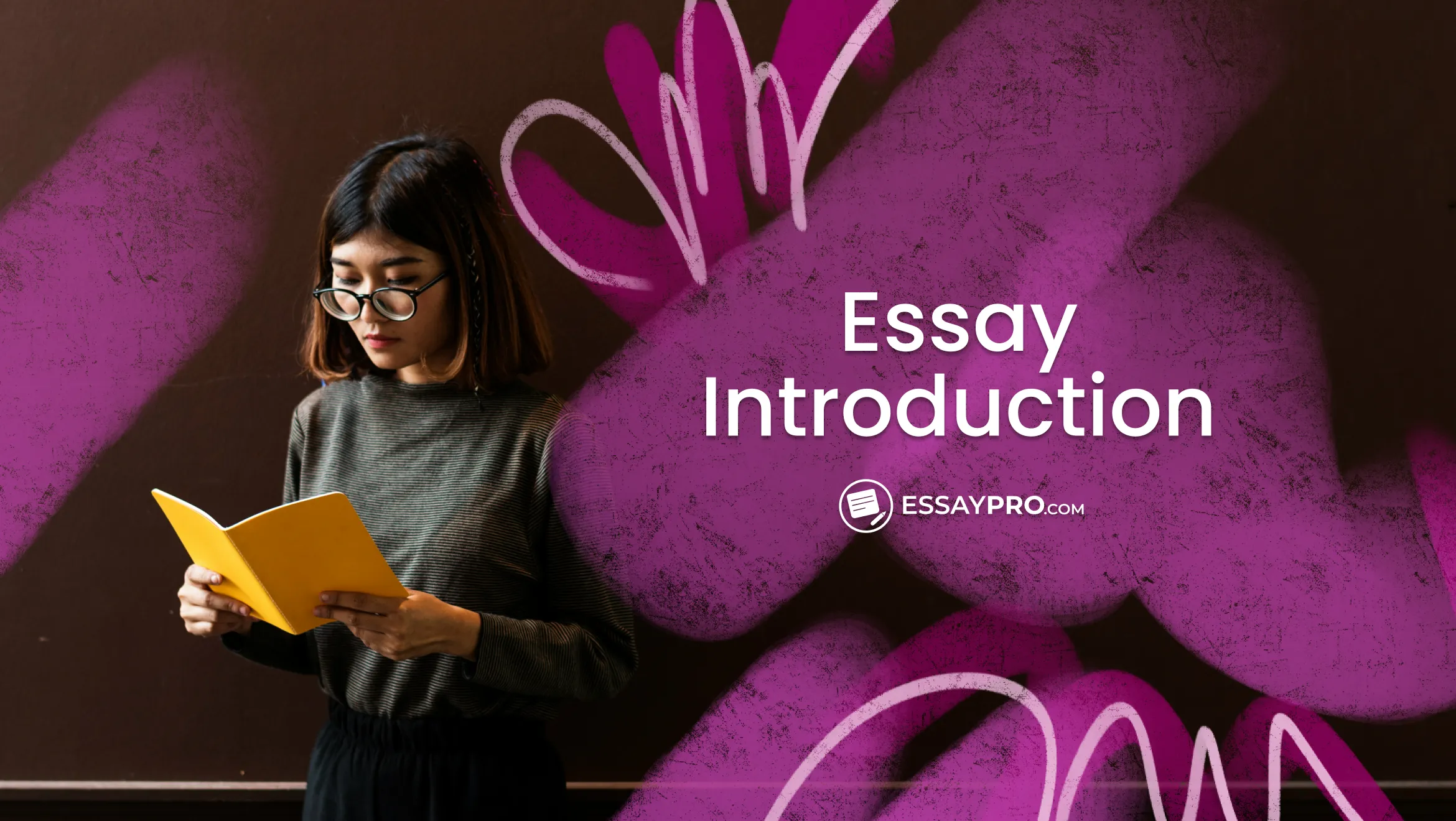An essay introduction is the first paragraph of the paper. It sets up the topic, gives the reader enough background to understand what’s coming, and states the thesis statement, which is the main point you plan to argue. Most introductions also signal the basic structure of the essay, so the reader has a rough idea of how the body paragraphs will unfold.
Here are some of the effective ways to open an essay:
- Catch the reader’s attention in a simple and direct way.
- Give background information that helps make sense of the topic.
- Present a clear thesis statement so the central idea is obvious.
Here’s a short example to show the format:
‘Plastic waste has become a persistent issue in many cities, and current systems still fail to keep up with the amount produced. This essay looks at why local recycling efforts fall behind and argues that stricter rules and better public education offer the most workable improvements.’
If you’re shaping early drafts or dealing with coursework, you can explore coursework writing services from EssayPro.


Essential Components
A strong introduction includes a few parts. Here’s how to write an essay introduction and what that section includes:
Hook: The first line pulls the reader in. It can be a fact, a question, or a quick detail that relates directly to the topic.
Background information: Background information gives context so the reader knows what the issue is. Define a term by naming a source or explaining the situation that the essay will discuss.
Thesis statement: Write the point of the essay in one sentence. The main point should be specific and debatable because the rest of the essay will support it.
Roadmap / short outline: Offer a quick preview of the key points the body paragraphs will cover. It does not need to be long, just enough to show where the argument is headed.
Transition into the essay: End the introduction with a sentence that moves the reader toward the first body paragraph.
How Long Should an Essay Introduction Be?
An essay introduction works best when it’s short and direct. For most academic essay tasks, 3–5 sentences are enough. In longer assignments, the introduction often takes up about 10 percent of the total word count.
Factors to keep in mind:
- Overall length: The introduction stays tight in short essays. Longer research papers, especially those with multiple body paragraphs, may require more space to set up the topic.
- Word count: A simple rule is to reserve roughly one-tenth of the essay’s total length for the introduction.
- Complexity: Some topics require background information before the reader can understand the thesis. More complex ideas usually need a slightly longer introduction.
- Purpose: Whatever the length, the introduction should orient the reader, offer clear background information, and end with a thesis statement that points toward the essay’s direction.
If you want help with evaluating how well your introduction performs, you can check guides on how to critique an article, which use similar skills.
Preparation Steps that Come First
Before writing an introduction, set up the groundwork. This means confirming the assignment requirements, checking what the topic demands, and deciding what the reader must know before meeting your thesis. The point is simple: reduce confusion later by making basic decisions early. Here’s how to start an essay introduction:
Providing Context
This section provides your readers with the basic facts, names, and definitions that make the rest of the essay easier to follow.
Keep this section simple and direct. Do not explain every detail here. Only include what prepares the reader for your main point.
Use orienting information to:
- Identify the topic in plain words so the reader knows exactly what the essay covers.
- Add essential background such as a short definition, a key idea, a brief summary of an author’s claim, or the main point of a debate.
- Match the context to the assignment. A research paper needs more background because the reader has not seen your sources. A response essay needs less because the class has already read the material.
- Connect every detail to the thesis. Anything that does not help the reader understand your claim belongs later in the body paragraphs.
The aim here is clarity. Give enough information so a reader feels oriented, but avoid extra facts that slow down the introduction.
Stating Your Thesis
Once the reader has the basic background, move to the claim you want to prove. This is the thesis statement. It should be specific, debatable, and written in plain language. The thesis tells the reader what argument the essay will build in the body paragraphs.
A strong thesis does two things:
- States your main claim clearly. The reader should know your exact position without having to guess.
- Explains why the claim matters. Point to the part of the issue your essay examines and why this angle is worth attention.
Avoid vague statements about why the topic matters in a general sense. Point the reader toward the exact idea your essay brings to the conversation and why that idea changes, sharpens, or clarifies something.
If you were writing about a Supreme Court ruling, the thesis should say what your essay contributes, for example, a closer look at one argument in the opinion or an explanation of how the ruling shifts a specific legal standard.
For students shaping legal or policy-related arguments, structured guidance can help. EssayPro also provides a law essay writing service that supports clear thesis development.
An Introduction Formula with an Example
This block walks through a straightforward way to write an introduction, one sentence at a time. The idea is to show what each part looks like in practice without making the structure feel rigid. To illustrate this, we’ll develop a small example topic as we progress: the rise of online learning in college education.
First Two Sentences: Context
Starting an essay with plain information helps the reader understand the setting. Keep it focused and factual.
Example:
'Over the past decade, colleges in many countries have expanded online learning. The shift began slowly, but enrollment in digital courses increased sharply once platforms became more reliable.'
This gives the reader enough background to see the subject without overwhelming them.
If you are writing a longer assignment like a term paper, you can review more detailed guidance here: How to write a term paper.
Third Sentence: Narrowing the Focus
Move from the broad topic to the specific angle your essay will examine. This reduces guesswork for the reader.
Example:
'Much of today’s debate centers on whether this expansion actually improves student learning.'
One sentence is enough. You’re simply telling the reader which part of the topic you’re zooming in on.
Fourth Sentence: Stating the Argument
Make your main point clear. Avoid complicated wording and say the claim directly.
Example:
'This essay argues that online learning supports stronger academic performance when colleges pair flexible course formats with active teacher support.'
The reader now knows what you plan to prove.
Fifth to Eighth Sentences: Unfolding the Argument
Explain the sequence your essay will follow. You’re giving the reader a map, and the clearer the path, the easier the reading experience.
Example:
'The discussion begins with a short look at how digital platforms changed course access. The next section examines data on student performance in hybrid versus fully online classes. After that, the role of teacher feedback will be reviewed, followed by a comparison of student engagement patterns across formats. The introduction of these points shows the steps leading to the final conclusion.'
Each sentence points to a section of the essay.
Final Sentences: Delivering the Thesis
Now restate the central claim in a direct, purposeful way. This is the line the entire essay will build toward.
Example:
'In the end, the argument is simple: flexible online formats and strong instructor support create measurable improvements in student outcomes. These combined factors make digital learning a practical model for modern colleges.'
Done: the Introduction is Complete
A clear introduction doesn’t need complicated language. It only needs to tell the reader what the essay covers, the angle you take, and how the discussion will unfold. When the structure is transparent, the reader can move through the essay without confusion, and your argument has a stronger impact.
Words to Start an Essay Introduction
Below, you will find strong ways to start an essay, each one setting up context, preparing the reader, and making it easier to transition toward the thesis.
Essay Introduction Examples
Below, you will find a PDF file that includes five clear introduction examples, each using a different approach and following the structure of context + background + thesis.
Tips for Writing Introductions
An introduction should guide the reader into the topic without explaining everything up front. Keep it practical and easy to follow.

- Start broad, then narrow: Open with a general idea and move toward the thesis. It gives the reader a clear starting point.
- Keep it brief: Aim for about 10–15 percent of the essay. Extra detail belongs later.
- Save evidence for later: State the thesis, but leave examples and proof for the body paragraphs.
- Write it after the body (optional): If the argument is easier to see once the paper is drafted, build the introduction last.
- Match the level of context to the assignment: Long research papers need more background. Short academic essays need less.
If you're working on larger projects like theses or dissertations, structured guidance can help. EssayPro offers a custom dissertation writing service to support planning and drafting.
Final Thoughts
A good introduction opens the essay the right way, gives the readers enough context, states an impactful thesis statement, and shows the direction of the argument. We walked you through the key parts of the introduction and several examples you can adapt to your own assignments. Keep the structure flexible and focus on clarity, and you will see that the introduction comes together with less effort.
FAQs
How Do I Start My Essay Introduction?
Start with a clear opening line that shows the topic. Add a few pieces of background information, then present your thesis statement. The goal is to make the reader understand the subject quickly without extra detail.
What Are the 5 Components of an Introduction?
A typical introduction includes a hook, context or background information, a clear thesis statement, a brief roadmap of the essay, and a transition that leads into the first body paragraph.
How to Write an Essay Introduction?
Begin with a strong opening sentence, give only the background your reader needs, define any key terms if they matter to the argument, and end with a thesis that states the main point of the essay. Keep the paragraph focused and connected to the body paragraphs that follow.
What Makes an Intro Boring?
Intros feel dull when they open with clichés, add too much background, include vague statements, or hide the thesis. Long generalities and dense sentences also slow down the reader.
What Are 5 Ways You Can Start Your Introduction?
You can begin with a short fact, a focused question, a brief statistic, a simple observation, or a dictionary definition of the topic. Each method works as long as it leads into your thesis and stays relevant to the paper.

Daniel Parker
is a seasoned educational writer focusing on scholarship guidance, research papers, and various forms of academic essays including reflective and narrative essays. His expertise also extends to detailed case studies. A scholar with a background in English Literature and Education, Daniel’s work on EssayPro blog aims to support students in achieving academic excellence and securing scholarships. His hobbies include reading classic literature and participating in academic forums.
- University of Hull. (n.d.). Essay introductions. https://libguides.hull.ac.uk/essays/intros
- University of Adelaide. (n.d.). Introductions and conclusions [PDF]. https://www.adelaide.edu.au/writingcentre/ua/media/14/learningguide-introductionsconclusions.pdf
- Sweetland Center for Writing. (n.d.). How do I write an intro, conclusion, and body paragraph? University of Michigan. https://lsa.umich.edu/sweetland/undergraduates/writing-guides/how-do-i-write-an-intro--conclusion----body-paragraph.html







